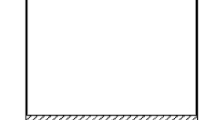Abstract
Usually, the problem of master nodes selection characterizes both computational or experimental modal analyses and defines the numerical properties of reduced models that possess equivalent dynamic properties. Methodologies based on experience are normally used or heavy time-consuming numerical algorithms can be applied. In that paper, the Modal-Geometrical Selection Criterion (MoGeSeC) is applied to a crankshaft, both for an EMA (experimental modal analysis) and for a reduction procedure applied on progressive numerical models. Then the results are compared with other literature criteria and algorithms. The nodes suggested by MoGeSeC and other criteria are used for identification tools of the dynamic behaviour of the crankshaft. In that way MoGeSeC proves to be a very quick and accurate method because the nodes it selects depicts very well modal features of the tested component. The proposed criterion is also applied to the component in order to evaluate the reduced inertia and stiffness matrices and their numerical ill-conditioning is measured. Also in that case MoGeSeC provides the analyzer with a good instrument for identification processes.
Access this chapter
Tax calculation will be finalised at checkout
Purchases are for personal use only
Preview
Unable to display preview. Download preview PDF.
Similar content being viewed by others
BIBLIOGRAPHY
M.I. Friswell, J.E. Mottershead, Finite Element Model Updating in Structural Dynamics, Dordrecht, Kluwer, 1995.
Maia N., Silva, J., “Theoretical and Experimental Modal Analysis”, Research Studies Press Ltd., New York, ISBN 978-0863802089, 1997.
J. Peck, I. Torres, A DMAP program for the selection of accelerometer locations in MSC/NASTRAN, in: Proc. 45th AIAA/ASME/ASCE/AHS/ASC Structures, Structural Dynamics and Materials Conference, Palm Springs, CA, USA, 2004, 19–22.
J.N. Ramsden, J.R. Stoker, Mass condensation – A semi-automatic method for reducing the size of vibration problems, International Journal for Numerical Methods in Engineering 1 (1969) 333–349.
B. Downs, Accurate reduction of stiffness and mass matrices for vibration analysis and a rationale for selecting master degree of freedom, ASME Journal of Mechanical Design 102 (1980) 412–416.
N. Popplewell, A.W. Bertels, B. Arya, A critical appraisal of the eliminating technique, Journal of Sound and Vibration 31 (2) (1973) 213–233.
V.N. Shah, M. Raymond, Analytical selection of masters for the reduced eigenvalue problem, International Journal of Numerical Methods in Engineering 18 (1982) 89–98.
K.W. Matta, Selection of dofs for dynamic analysis, Journal of Pressure Vessel Technology 109 (1) (1987) 65–69.
N.I. Grinenko, V.V. Mokeev, Problems of studying vibrations of structures by the finite element method, (English trans.), Prikladnaya Mekhanika 21 (1985) 231–235.
W. Li, A degree selection method of matrix condensations for eigenvalue problems, Journal of Sound and Vibration 259 (2) (2003) 409–425.
D.C. Kammer, R.D. Brillhart, Optimal sensor placement for modal identification using system-realization methods, Journal of Guidance, Control and Dynamics 19 (1996) 729–731.
M. Meo, G. Zumpano, On the optimal sensor placement techniques for a bridge structure, Engineering Structures 27 (2005) 1488–1497.
D.S. Li, H.N. Li, C.P. Fritzen, The connection between effective independence and modal kinetic energy methods for sensor placement, Journal of Sound and Vibration 305 (2007) 945–955.
J. O’Callahan, P. Avitabile, R. Riemer, System equivalent reduction expansion process (SEREP), in: Proc. 7th IMAC, Las Vegas, Nevada, USA, 1989, 29–37.
D.C. Kammer, M.L. Tinker, Optimal placement of triaxial accelerometers for model vibration tests, Journal of Mechanical Systems and Signal Processing 18 (2004) 29–41.
R.J. Allemang, D.L. Brown, A correlation coefficient for modal vector analysis, in: Proc. 1st IMAC, Orlando, Florida, USA, 1982, 110–116.
R.D. Henshell, J.H. Ong, Automatic masters for eigenvalue economization, Earthquake Engineering Structural Dynamics 3 (1975) 375–383.
E. Bonisoli, C. Delprete, C. Rosso, “Comparison between dynamic condensation techniques in automotive application”, SAE 2006 World Congress, 2006, Detroit, Michigan, April 3-6, ISSN: 0148-7191, SAE Technical Paper 2006-01-1093, pp. 1-8.
E. Bonisoli, C. Delprete, C. Rosso, “A modal-geometrical selection criterion in dynamic condensation techniques”, Proceedings of ESDA 2006, 8 th Biennial ASME Conference on Engineering Systems Design and Analysis, 2006, Torino, Italy, July 4-7, Paper ESDA2006-95469, pp. 1-8.
E. Bonisoli, C. Delprete, C. Rosso, “Proposal of a modal-geometrical-based master nodes selection criterion in modal analysis”, Mechanical Systems and Signal Processing, April 2009, 23(3), ISSN: 0888-3270, DOI: 10.1016/j.ymssp.2008.05.012, pp. 606-620.
R.J. Guyan, Reduction of stiffness and mass matrices, AIAA Journal 3 (2) (1965) 380.
R.R. Craig, M.C.C. Bampton, Coupling of substructures for dynamic analyses, AIAA Journal 6 (7) (1968) 1313–1319.
G.H. Golub, C.F. Van Loan, Matrix computations, North Oxford Academy, London, UK, 1986.
Author information
Authors and Affiliations
Editor information
Editors and Affiliations
Rights and permissions
Copyright information
© 2011 Springer Science+Business Media, LLC
About this paper
Cite this paper
Bonisoli, E., Delprete, C., Rosso, C. (2011). A Modal-Geometrical Selection Criterion for Master Nodes: Numerical and Experimental Testing. In: Proulx, T. (eds) Linking Models and Experiments, Volume 2. Conference Proceedings of the Society for Experimental Mechanics Series. Springer, New York, NY. https://doi.org/10.1007/978-1-4419-9305-2_20
Download citation
DOI: https://doi.org/10.1007/978-1-4419-9305-2_20
Published:
Publisher Name: Springer, New York, NY
Print ISBN: 978-1-4419-9304-5
Online ISBN: 978-1-4419-9305-2
eBook Packages: EngineeringEngineering (R0)




